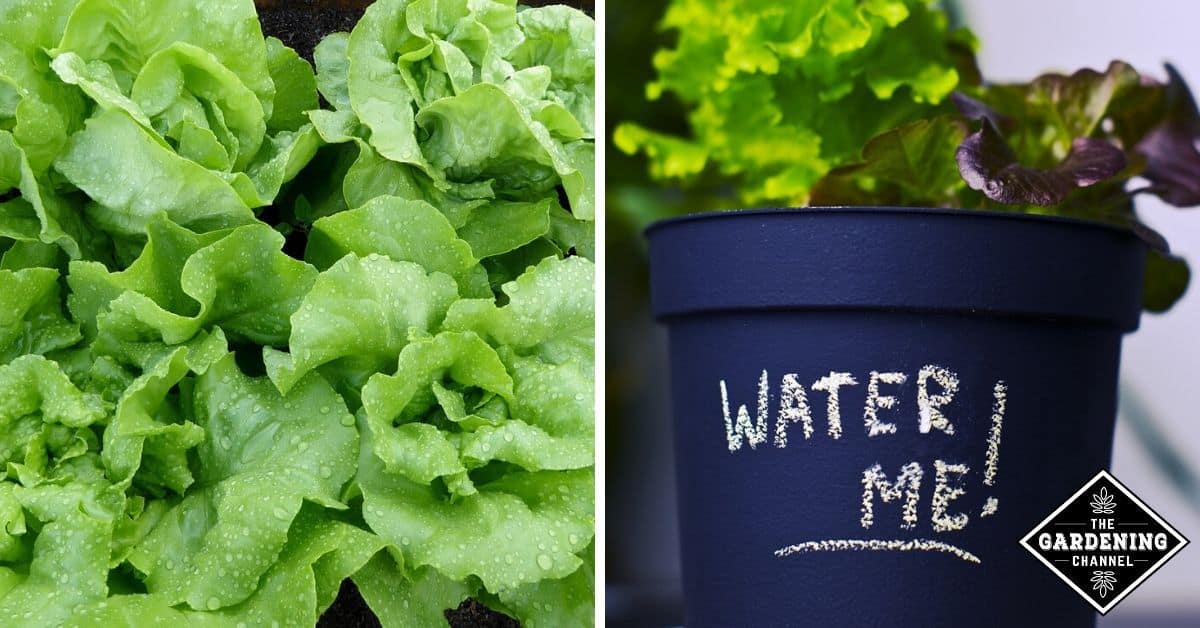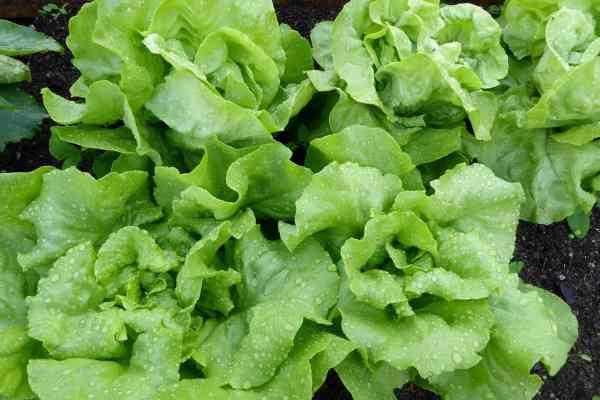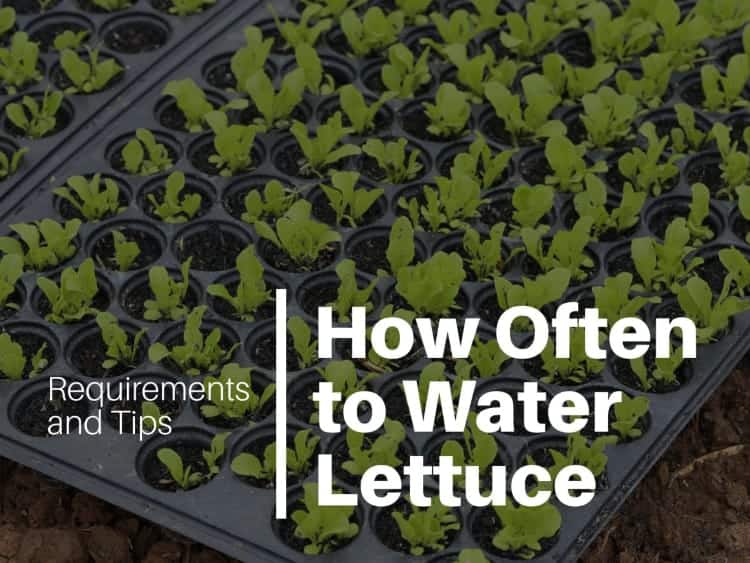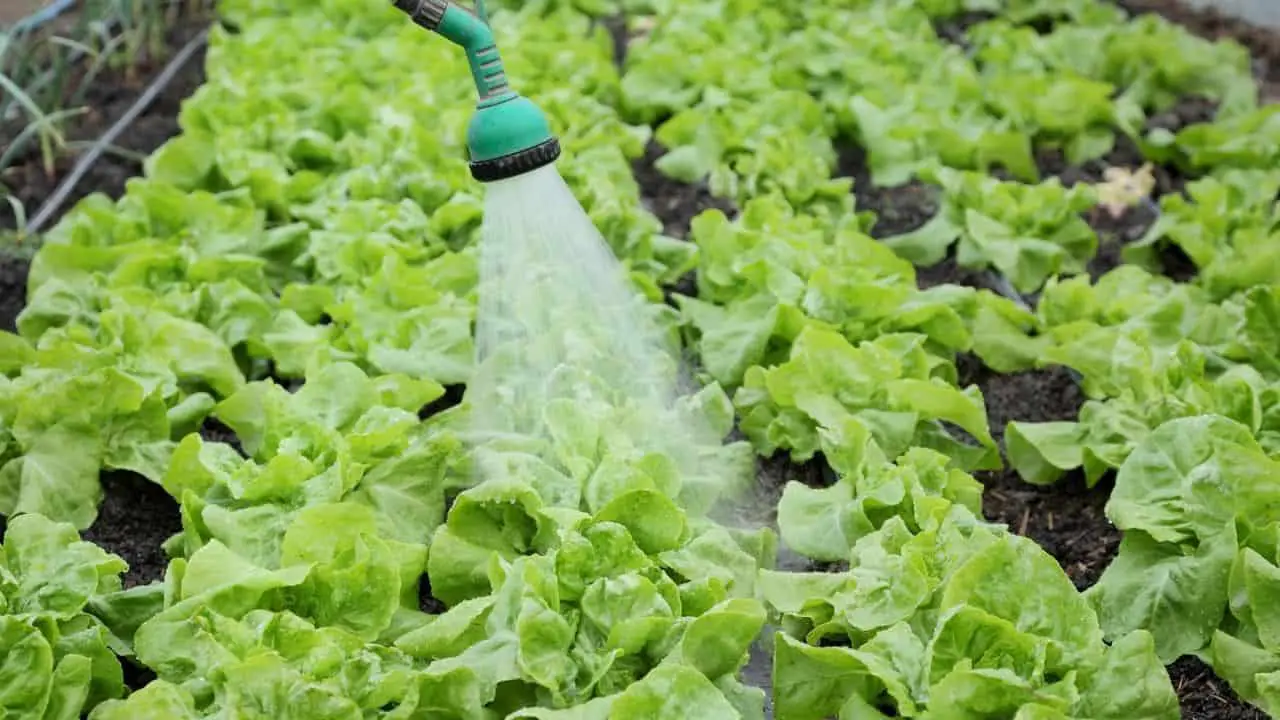Alright, so you’ve decided to try your hand at growing lettuce. Great choice! But here’s the thing – to ensure your lettuce grows healthy and vibrant, you need to know how to properly water it. So, let’s get right to it. In this article, we’ll guide you through the essential steps to watering your lettuce in a week. You’ll learn how much water your lettuce needs, the best time to water it, and some helpful tips to keep your lettuce thriving. So, grab your watering can and let’s get started!

Understanding Water Needs of Lettuce
When it comes to growing lettuce, understanding its water needs is crucial for ensuring healthy growth and maximizing yields. Lettuce is a highly water-dependent crop, and various factors can affect its water requirements. By understanding these factors and the recommended water requirements, you can provide your lettuce plants with the optimal amount of water they need. Additionally, understanding soil moisture levels is essential for maintaining the right balance of water in the soil.
Factors Affecting Water Needs
Several factors influence the water needs of lettuce. These factors include the stage of growth, environmental conditions, climate, soil type, and the overall health of the plants.
During different growth stages, lettuce plants have varying water requirements. For example, young lettuce seedlings require less water than mature plants. Environmental conditions such as high temperatures and low humidity can increase the water needs of lettuce. Likewise, dry and arid climates generally require more irrigation compared to regions with a higher moisture content in the air. The type of soil also plays a role, as sandy soils dry out faster than clay or loamy soils. Additionally, the overall health of the plants affects their ability to absorb and utilize water effectively.
Recommended Water Requirements
On average, lettuce plants require approximately 1 to 1.5 inches of water per week. However, it’s important to note that this is a general guideline, and the specific water needs can vary based on the factors mentioned above. Monitoring the moisture levels in the soil and observing the condition of the plants can help you determine whether they require more or less water.
Understanding Soil Moisture Levels
Understanding soil moisture levels is crucial for proper watering. Overwatering or underwatering can lead to various problems, including root rot, stunted growth, and reduced yields. To determine soil moisture levels, you can conduct a touch test or use moisture sensors if available. A touch test involves gently touching the soil with your finger to assess its moisture content. If the soil feels dry to the touch, it’s an indication that the plants need watering. On the other hand, if the soil feels overly saturated and muddy, it may be a sign of overwatering.
Choosing the Right Irrigation Method
Selecting the appropriate irrigation method is essential for delivering water efficiently to lettuce plants. There are several irrigation methods available, and choosing the right one depends on factors such as water efficiency, plant health, and ease of implementation in your specific growing conditions.
Drip Irrigation
Drip irrigation is a highly efficient method for watering lettuce. It involves the use of drip lines or drip emitters to deliver a slow and steady supply of water directly to the plant’s root zone. This method minimizes water wastage by reducing evaporation and runoff, and it also helps in preventing foliage diseases by avoiding wetting the leaves. Drip irrigation can be easily automated and controlled, making it an ideal choice for large-scale lettuce cultivation.
Sprinkler Irrigation
Sprinkler irrigation is another common method used for watering lettuce. It involves the use of sprinklers that distribute water over the plants in a spray-like manner. While sprinkler irrigation is effective in covering a large area, it can result in more water loss due to evaporation and wind drift. To minimize these losses, it’s recommended to use sprinklers with low precipitation rates and adjust the watering schedule to avoid watering during hot and windy periods.
Hand Watering Techniques
Hand watering can be a suitable method for smaller-scale lettuce cultivation or home gardeners. It provides more control over the amount of water applied and allows for immediate adjustments based on specific plant needs. When hand watering lettuce, it’s important to direct the water at the base of the plants to avoid wetting the foliage. This helps in preventing the spread of diseases and reduces the risk of fungal infections. Additionally, using a watering can or a hose with a gentle flow can help in delivering water more effectively without causing soil erosion.

Preparing the Watering Schedule
Establishing a proper watering schedule is vital for consistently providing your lettuce plants with the required amount of water. Several factors should be considered when preparing a watering schedule, including climate and environmental conditions, optimal watering frequency, and adjusting the schedule for different growth stages.
Assessing Climate and Environmental Conditions
The climate and environmental conditions in your specific growing region play a significant role in determining the watering needs of lettuce. In hot and dry climates, lettuce plants may require more frequent watering, while in cooler and more humid climates, they may need less water. Factors such as temperature, humidity, and wind speed should be taken into account when assessing the watering requirements.
Determining Optimal Watering Frequency
The optimal watering frequency for lettuce depends on various factors such as soil type, plant size, and weather conditions. As mentioned earlier, lettuce plants generally require around 1 to 1.5 inches of water per week. However, rather than watering your plants with a fixed amount of water at set intervals, it’s important to monitor the soil moisture levels and observe the condition of the plants. This will help you determine the ideal watering frequency. Aim to water the plants when the soil feels dry to the touch, but avoid allowing the soil to become overly saturated or waterlogged.
Adjusting Schedule for Different Growth Stages
Lettuce plants go through different growth stages, and their water requirements can vary accordingly. Young lettuce seedlings and transplants require more frequent watering to establish strong root systems, while mature plants may require less water. As the plants develop and their root systems expand, you can adjust the watering schedule accordingly. Monitor the soil moisture and the overall health of the plants to ensure they receive the appropriate amount of water.
Proper Application of Water
The way you apply water to lettuce plants can significantly impact their overall health and productivity. There are a few essential practices to follow to ensure the proper application of water.
Watering at the Base of Plants
When watering lettuce, it’s best to apply water at the base of the plants rather than overhead. Watering at the base helps in delivering water directly to the root zone where it’s needed the most. This method reduces the risk of fungal diseases and minimizes water wastage due to evaporation. Use drip irrigation or direct the flow of water from a watering can or hose close to the soil surface to ensure effective water penetration.
Avoiding Wetting the Foliage
Wetting the foliage of lettuce plants should be avoided whenever possible. Moisture on the leaves can create a favorable environment for fungal diseases, such as powdery mildew and lettuce leaf spot. By directing the water at the base of the plants, you can minimize the risk of foliage diseases and ensure healthy plant growth. Additionally, watering during the morning hours allows for leaves to dry off during the day, reducing the likelihood of disease development.
Utilizing Mulch for Moisture Retention
Mulching around the base of lettuce plants can help in conserving soil moisture and reducing water evaporation. Apply a layer of organic mulch, such as straw or shredded leaves, to the soil surface. Mulch acts as a barrier that prevents water from evaporating quickly and helps in maintaining more consistent soil moisture levels. It also provides an added benefit of controlling weed growth and improving soil health over time.

Monitoring Soil Moisture
Regularly monitoring the soil moisture levels is essential for preventing overwatering or underwatering of lettuce plants. There are various methods to assess soil moisture, including using moisture sensors, conducting a touch test, and observing plant wilting.
Using Moisture Sensors
Moisture sensors are an effective tool for monitoring soil moisture levels accurately. These sensors can be inserted into the soil, and they provide real-time data on the moisture content. Depending on the type of sensor used, it can indicate whether the soil is too wet, too dry, or at an optimal moisture level. Utilizing moisture sensors in your lettuce garden can help you make informed decisions about when to water and prevent both overwatering and underwatering.
Conducting a Touch Test
The touch test is a simple and cost-effective way to check soil moisture levels. Gently insert your finger into the soil up to the first knuckle and take note of how the soil feels. If it feels dry, it’s an indication that the plants require watering. If it feels moist, it means the soil has sufficient moisture and does not require immediate watering. Practice the touch test at different spots in your garden to get an overall idea of the soil moisture levels.
Observing Plant Wilting
Plant wilting is a visible sign that the soil lacks sufficient moisture. While it’s not the most accurate method for assessing soil moisture, wilting can serve as an indicator that watering is needed. However, it’s important to note that severe wilting can cause irreversible damage to the plants. Therefore, it’s advisable to monitor the soil moisture levels using other methods mentioned above to prevent wilting from occurring.
Identifying Signs of Overwatering or Underwatering
Understanding the signs of overwatering and underwatering is crucial for adjusting your watering practices accordingly and preventing detrimental effects on lettuce plants.
Effects of Overwatering
Overwatering can lead to various negative effects on lettuce plants. The roots of overwatered plants can become waterlogged, leading to reduced oxygen availability and root rot. Over time, this can cause stunted growth, yellowing of leaves, and wilting despite the soil being moist. Overwatered lettuce plants are also more susceptible to fungal diseases, such as damping-off and root rot. Adjusting your watering practices by reducing the frequency or volume of water can help alleviate the effects of overwatering.
Effects of Underwatering
Underwatering can also have detrimental effects on lettuce plants. Insufficient water can lead to wilting, reduced growth, and premature bolting (flowering). Leaves may become dry, brittle, and discolored. Underwatered plants are more prone to stress, making them susceptible to pests and diseases. Providing an adequate amount of water at the right frequency can help prevent the negative effects of underwatering. Adjust your watering schedule or increase the volume of water applied to match the needs of the plants.
Adjusting Watering Practices Accordingly
Identifying signs of overwatering or underwatering allows you to adjust your watering practices accordingly. If the soil moisture levels indicate overwatered or underwatered conditions, make necessary adjustments to your watering schedule. This may include reducing or increasing the frequency and/or volume of water applied. Remember to always consider the specific needs of your lettuce plants based on factors such as climate, soil type, and growth stage.

Additional Tips for Proper Watering
In addition to the main watering practices discussed, here are a few additional tips to ensure proper watering of lettuce plants:
Watering in the Morning
Watering your lettuce plants in the morning is generally recommended. Morning watering allows the leaves to dry off during the day, reducing the risk of fungal diseases and promoting overall plant health. Watering in the afternoon or evening can lead to prolonged leaf wetness, which can increase the likelihood of disease development.
Avoiding Waterlogging
Avoiding waterlogging is crucial for preventing root rot and other moisture-related issues. Ensure that the soil has adequate drainage so that excess water can easily drain away. If your soil has poor drainage, consider incorporating organic matter or creating raised beds to improve drainage.
Monitoring Rainfall Levels
Keep track of the amount of rainfall your lettuce plants receive. If there has been sufficient rainfall, it may not be necessary to water your plants immediately. However, if rainfall is sporadic or inadequate, you may need to supplement with additional irrigation. Regularly monitoring rainfall levels allows you to adjust your watering schedule accordingly.
Avoiding Common Watering Mistakes
To ensure the health and productivity of your lettuce plants, it’s important to avoid common watering mistakes that can negatively impact their growth.
Overwatering During Cooler Seasons
During cooler seasons, lettuce plants tend to have lower water requirements. Overwatering during these periods can result in waterlogged soil and increased susceptibility to diseases. Adjust your watering schedule accordingly, reducing the frequency and volume of water applied to prevent overwatering during cooler seasons.
Neglecting Watering During Heatwaves
Heatwaves can quickly dry out the soil and cause moisture stress in lettuce plants. During extreme heat, it’s important to provide adequate water to prevent wilting and dehydration. Increase the frequency and volume of watering during heatwaves to compensate for the increased evaporation rates.
Watering Too Frequently
While it’s crucial to provide sufficient water to lettuce plants, watering too frequently can lead to overwatering and associated problems. Avoid the temptation to water your plants daily without considering their specific needs. Instead, rely on the soil moisture levels and the condition of the plants to determine the appropriate watering frequency.

Troubleshooting Watering Issues
Sometimes, despite your best efforts, you may encounter watering issues that require troubleshooting. Here are a few common watering problems and how to address them:
Addressing Drainage Problems
If you notice excessive pooling of water or slow water absorption in the soil, it may indicate drainage problems. Poor drainage can lead to waterlogged soil and adversely affect the health of your lettuce plants. To address drainage problems, consider amending the soil with organic matter or creating channels to divert excess water away from the planting area. In severe cases, constructing raised beds or installing drainage systems may be necessary.
Dealing with Excessive Runoff
Excessive runoff can occur when the soil becomes compacted or when the watering rate exceeds the soil’s ability to absorb water. Runoff not only wastes water but can also deprive your lettuce plants of the necessary moisture. To address excessive runoff, take measures to improve soil structure and porosity. Incorporate organic matter into the soil to enhance its water-holding capacity and reduce surface runoff.
Seeking Professional Advice
If you’re facing persistent watering issues or struggling to determine the appropriate watering practices for your lettuce plants, it may be helpful to seek professional advice. Local agronomists, horticulturists, or experienced farmers can provide valuable insights and guidance specific to your growing region. They can assess your specific situation, analyze the soil and plant health, and offer personalized recommendations to address your watering challenges.
Conclusion
Proper watering practices are essential for the healthy growth and development of lettuce plants, leading to higher yields and better quality produce. Understanding the water needs of lettuce, selecting the right irrigation method, preparing an appropriate watering schedule, and ensuring proper application of water are all key components of successful lettuce cultivation. By monitoring soil moisture, identifying signs of overwatering or underwatering, and avoiding common watering mistakes, you can create an optimal growing environment for your lettuce plants. Incorporating these practices into your lettuce cultivation will help maximize yields and ensure the overall success of your lettuce garden.



